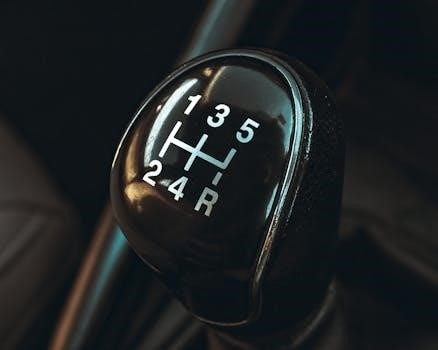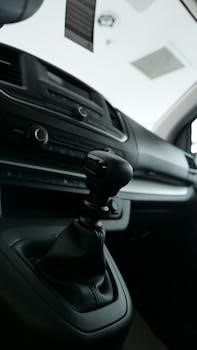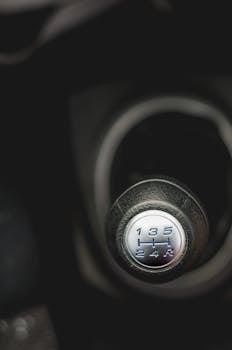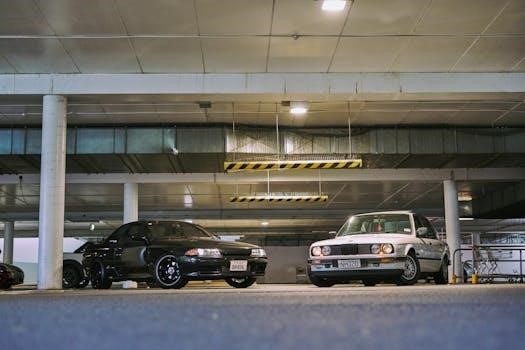
-
By:
- ophelia
- No comment
auto to manual transmission swap
Auto to Manual Transmission Swap⁚ A Comprehensive Guide
Considering a manual transmission swap? This guide provides a comprehensive overview of the process, costs, and considerations involved in converting your automatic vehicle to a manual. Weigh the pros and cons before diving in!
Understanding the Manual Swap Process
Embarking on a manual transmission swap requires careful planning and execution. The initial step involves thorough research to identify the specific components needed for your vehicle’s make and model. Compatibility is key, ensuring that the chosen manual transmission will properly integrate with your engine and chassis. A detailed cost analysis is crucial, encompassing the price of parts, potential labor charges, and any unforeseen expenses that may arise during the conversion. Sourcing the necessary parts is a critical phase, involving the acquisition of the transmission itself, along with essential components such as the clutch, flywheel, master cylinder, and potentially a new driveshaft. The process typically involves removing the existing automatic transmission, installing the manual transmission, and connecting all necessary linkages and controls. This may also require modifications to the vehicle’s wiring harness and computer system to accommodate the new transmission. Professional installation is often recommended, as it ensures proper alignment and functionality. However, DIY options exist for experienced mechanics. Before commencing the swap, consider the potential impact on your vehicle’s resale value and overall performance. Thoroughly research all aspects of the process to make an informed decision.

Cost Analysis⁚ Factors Influencing the Price
The cost of an automatic to manual transmission swap is highly variable, influenced by a multitude of factors. The vehicle’s make and model play a significant role, as some vehicles are inherently more compatible with manual transmissions than others, leading to variations in parts availability and installation complexity. The type of transmission chosen also impacts the overall cost, with new or rebuilt transmissions commanding a higher price than used options; Labor charges represent a substantial portion of the expense, and these can fluctuate depending on the mechanic’s expertise and the shop’s hourly rate. Additional parts and components, such as the clutch, flywheel, master cylinder, and driveshaft, contribute to the total cost. Modifications to the wiring harness and computer system may also be necessary, adding further expense. Geographic location can influence prices due to variations in labor rates and parts availability. Unexpected expenses, such as unforeseen repairs or the need for specialized tools, should be factored into the budget. Obtaining quotes from multiple mechanics is essential to compare prices and ensure transparency. Consider the long-term costs associated with the swap, including potential maintenance and repair expenses. Thoroughly evaluate all factors to gain a realistic understanding of the financial investment involved. A detailed cost breakdown will aid in making an informed decision and avoiding unexpected financial burdens during the conversion process.
Essential Parts and Components Needed
A successful automatic to manual transmission swap necessitates a comprehensive collection of essential parts and components. The manual transmission itself is the core element, requiring careful selection based on compatibility and desired performance characteristics. A matching clutch kit, including the clutch disc, pressure plate, and throw-out bearing, ensures proper engagement and disengagement of the transmission. The flywheel, which connects the engine to the transmission, must be compatible with the chosen clutch and transmission. A manual transmission pedal assembly, encompassing the clutch pedal, brake pedal (if necessary), and accelerator pedal, facilitates driver control. A master cylinder and slave cylinder, integral to the hydraulic clutch system, enable clutch actuation. The shift linkage or cable system, connecting the gear shifter to the transmission, allows for gear selection. A driveshaft, tailored to the manual transmission’s length and specifications, transmits power from the transmission to the rear differential. The transmission mount, supporting the transmission within the vehicle’s chassis, ensures stability. A manual transmission-specific wiring harness, integrating with the vehicle’s electrical system, enables proper functionality. A manual transmission control unit (if required), managing various transmission functions, may be necessary for certain vehicles. Interior trim pieces, such as the shift boot and center console, provide a finished appearance. Miscellaneous hardware, including bolts, nuts, and washers, secures the components in place. Sourcing high-quality parts is crucial for reliability and longevity. Thoroughly researching and acquiring all necessary components is essential for a seamless and successful conversion. Consulting with experienced mechanics or online forums can aid in identifying specific parts requirements.
Vehicle Make and Model Compatibility
Vehicle make and model compatibility is a paramount consideration when contemplating an automatic to manual transmission swap. The feasibility and complexity of the swap are heavily influenced by the vehicle’s original design and the availability of compatible parts. Vehicles that were originally offered with both automatic and manual transmission options generally present a more straightforward conversion process. In such cases, the necessary mounting points, wiring harnesses, and other supporting infrastructure may already be present, simplifying the installation. However, even within the same make and model, variations in engine type, chassis configuration, and trim level can affect compatibility. It’s crucial to verify that the chosen manual transmission is compatible with the vehicle’s engine, driveline, and electronic control systems; Some vehicles may require custom modifications or fabrication to accommodate the manual transmission, increasing the complexity and cost of the swap. Vehicles that were never offered with a manual transmission option may pose significant challenges, necessitating extensive modifications and potentially rendering the swap impractical. Researching online forums, consulting with experienced mechanics, and examining technical documentation can provide valuable insights into the compatibility of specific vehicle makes and models. Identifying potential compatibility issues early in the planning process can prevent costly mistakes and ensure a successful conversion. A thorough assessment of vehicle-specific factors is essential for determining the feasibility and scope of the manual transmission swap. The availability of aftermarket parts and support can also significantly impact the ease and affordability of the conversion. Selecting a compatible vehicle make and model is a critical step in ensuring a smooth and successful automatic to manual transmission swap.
DIY vs. Professional Installation

The decision between DIY (Do-It-Yourself) and professional installation for an automatic to manual transmission swap is a crucial one, heavily dependent on your mechanical skills, available tools, and budget. A DIY approach can significantly reduce labor costs, potentially saving you a substantial amount of money. However, it requires a solid understanding of automotive mechanics, including transmission systems, wiring diagrams, and diagnostic procedures. You’ll need access to a well-equipped garage with essential tools such as a transmission jack, socket sets, torque wrenches, and diagnostic scanners. Furthermore, you should be comfortable working under a vehicle for extended periods and possess the ability to troubleshoot unexpected issues that may arise during the swap. DIY installation also demands a significant time commitment, as the process can take several days or even weeks to complete, depending on your experience level and the complexity of the swap. If you lack the necessary skills, tools, or time, professional installation is the more prudent option. Hiring a qualified mechanic or transmission specialist ensures that the swap is performed correctly, minimizing the risk of errors and potential damage to your vehicle. Professional installation also provides the peace of mind that comes with knowing the job is backed by a warranty. However, labor costs can be substantial, potentially exceeding the cost of the parts themselves. When choosing a professional installer, it’s essential to research their experience and reputation, read online reviews, and obtain multiple quotes to compare prices. Discuss the scope of the project in detail, including any potential unforeseen expenses, to avoid surprises later on. Ultimately, the decision between DIY and professional installation depends on your individual circumstances and comfort level. Carefully assess your skills, resources, and budget before making a choice that aligns with your capabilities and ensures a successful transmission swap.
Potential Problems and Challenges
Undertaking an automatic to manual transmission swap is a complex project fraught with potential problems and challenges that can significantly impact the outcome and overall cost. One of the most common issues is parts compatibility. Ensuring that all components, including the transmission, clutch, flywheel, and associated hardware, are compatible with your specific vehicle make and model is crucial. Mismatched parts can lead to installation difficulties, performance issues, and even damage to the engine or transmission. Electrical complications are another significant hurdle. Modern vehicles rely heavily on electronic control systems, and the transmission swap may require modifications to the wiring harness, ECU (Engine Control Unit), or other electronic components. Failure to properly integrate the new transmission with the vehicle’s electrical system can result in warning lights, malfunctioning sensors, and drivability problems. Another potential challenge is the need for custom fabrication or modification. Depending on the vehicle and the chosen transmission, it may be necessary to fabricate custom brackets, modify the driveshaft, or adapt the shifter linkage. These modifications require specialized skills and equipment and can add significantly to the overall cost of the swap. Furthermore, unforeseen issues can arise during the installation process, such as stripped bolts, damaged components, or unexpected compatibility problems. These issues can require additional time, money, and expertise to resolve. It’s also essential to consider the potential impact on the vehicle’s resale value. While a manual transmission swap may enhance the driving experience for some enthusiasts, it can also deter potential buyers who prefer automatic transmissions. Before embarking on a transmission swap, it’s crucial to thoroughly research the potential problems and challenges associated with your specific vehicle and the chosen transmission. Consulting with experienced mechanics or transmission specialists can provide valuable insights and help you anticipate and mitigate potential issues. Careful planning and preparation are essential for a successful and trouble-free transmission swap.
Is a Manual Swap Worth the Investment?

Deciding whether a manual transmission swap is worth the investment requires careful consideration of several factors, weighing the potential benefits against the associated costs and challenges. One of the primary benefits of a manual swap is the enhanced driving experience. Many enthusiasts prefer the greater control and engagement offered by a manual transmission, allowing for more precise gear selection and a more direct connection to the engine. This can translate into a more enjoyable and rewarding driving experience, particularly for those who appreciate performance driving. Another potential benefit is improved fuel economy. In some cases, a manual transmission can offer better fuel efficiency than an automatic transmission, especially in older vehicles. However, this is not always the case, as modern automatic transmissions have become increasingly efficient. The decision to invest in a manual swap also depends on the vehicle’s intended use. If the vehicle is primarily used for commuting or daily driving, the benefits of a manual transmission may not outweigh the added cost and complexity. However, if the vehicle is used for performance driving, track days, or autocross events, the enhanced control and engagement of a manual transmission can be a significant advantage. The cost of the swap is a major consideration. As discussed earlier, the cost can vary widely depending on the vehicle, the chosen transmission, and the availability of parts. It’s essential to obtain accurate estimates from reputable mechanics or transmission specialists before making a decision. The potential impact on the vehicle’s resale value should also be considered. While a manual transmission swap may appeal to some enthusiasts, it can also deter potential buyers who prefer automatic transmissions. This can negatively impact the vehicle’s resale value, especially if the swap is not performed to a high standard. Ultimately, the decision of whether a manual swap is worth the investment is a personal one. It depends on individual priorities, driving preferences, and budget considerations. Carefully weighing the potential benefits against the associated costs and challenges is essential for making an informed decision.
Alternatives to a Transmission Swap

If the cost, complexity, or potential challenges of a manual transmission swap seem daunting, several alternatives can provide a similar level of driving enjoyment or address the underlying reasons for considering the swap in the first place. One of the most straightforward alternatives is to simply purchase a vehicle that already has a manual transmission. This eliminates the need for any modifications or conversions, and it ensures that the vehicle is designed and engineered to work seamlessly with a manual transmission. This is often the most cost-effective and reliable option, especially if the primary goal is to experience the thrill of driving a manual car. Another alternative is to consider upgrading the existing automatic transmission. Modern automatic transmissions have come a long way in recent years, and many offer features such as paddle shifters, sport modes, and adaptive learning capabilities that can enhance the driving experience. Upgrading to a higher-performance automatic transmission can provide improved shift response, better acceleration, and a more engaging driving experience without the need for a full manual swap. For those seeking improved performance, other modifications can be made to the engine, suspension, or brakes. These modifications can enhance the overall driving experience and provide a similar level of excitement and engagement as a manual transmission. Upgrading the engine with a performance chip or exhaust system can increase horsepower and torque, while upgrading the suspension can improve handling and cornering ability. If the primary reason for considering a manual swap is to improve fuel economy, other options may be more effective. Simple steps such as reducing weight, improving aerodynamics, and using low-rolling-resistance tires can significantly improve fuel efficiency without the need for a transmission swap. Additionally, driving habits can have a significant impact on fuel economy, so practicing smooth acceleration, avoiding hard braking, and maintaining a steady speed can all help to improve gas mileage. Ultimately, the best alternative to a manual transmission swap depends on the individual’s specific goals and priorities. By carefully considering the various options and weighing the pros and cons of each, it is possible to find a solution that provides the desired level of driving enjoyment or addresses the underlying reasons for considering the swap in the first place.